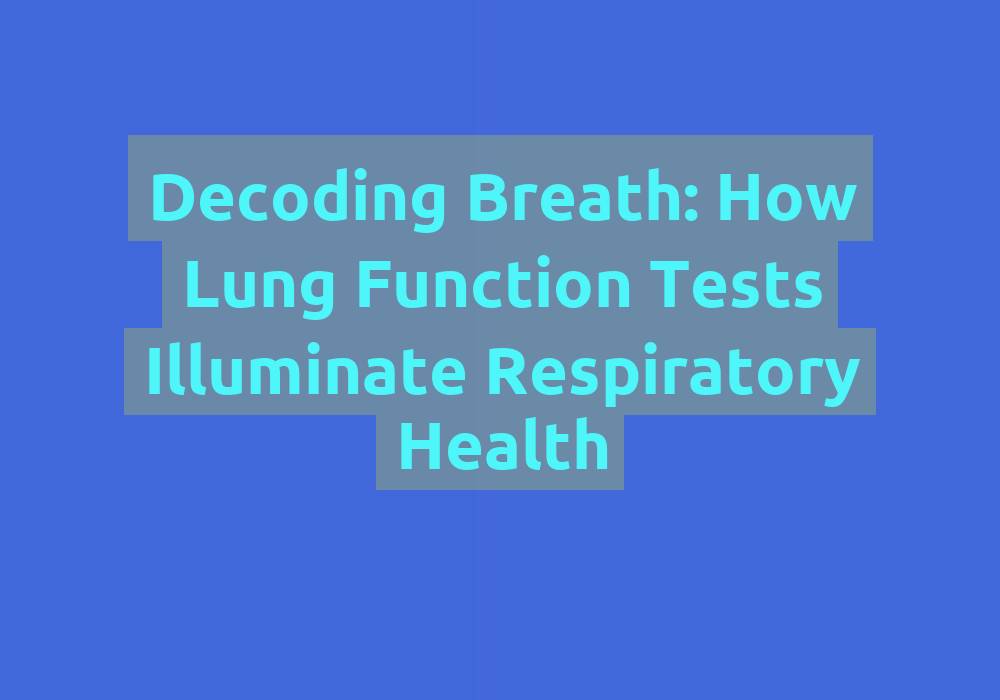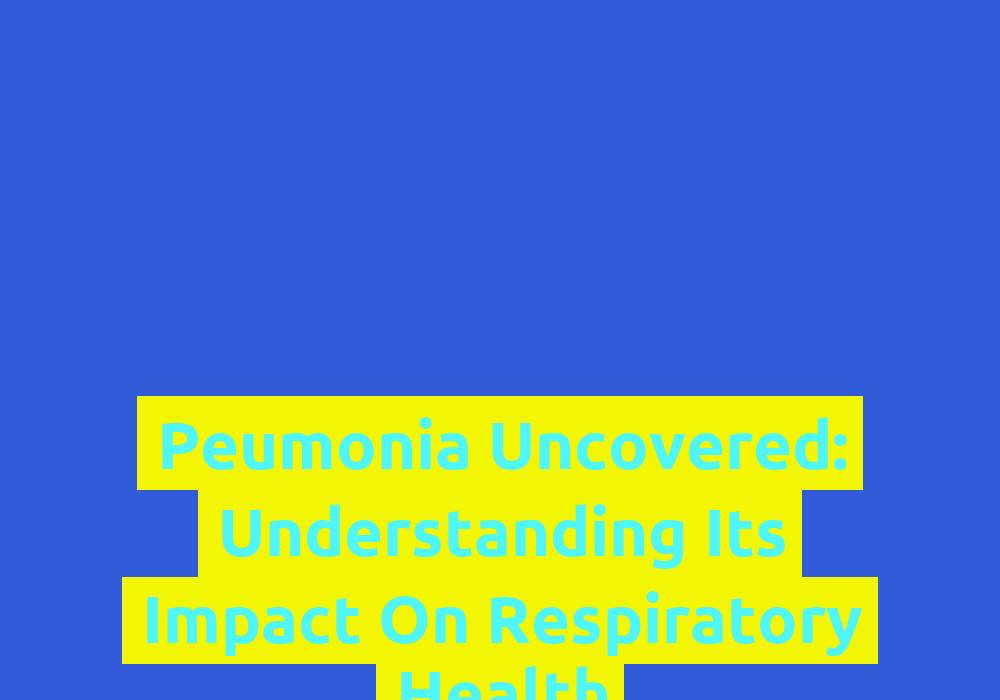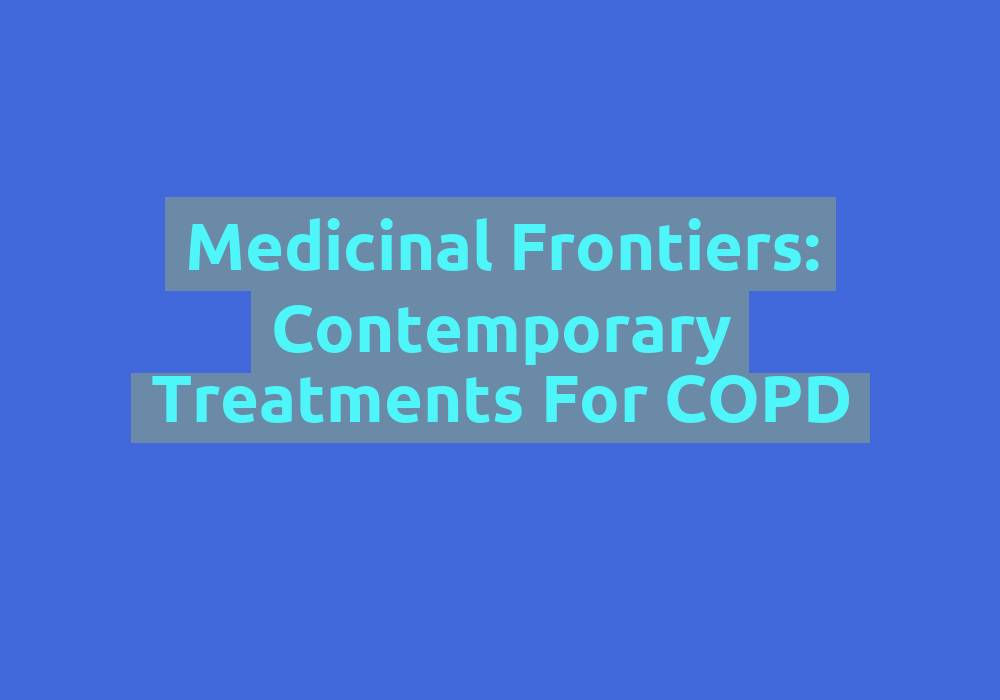Unraveling Asthma: Pathways to Healthier Respiratory Function

Asthma is a chronic respiratory condition that affects millions of people worldwide. It is characterized by recurring episodes of wheezing, coughing, shortness of breath, and chest tightness. While there is no cure for asthma, there are various strategies and treatments available to manage the condition effectively and improve respiratory function. In this article, we will explore different pathways to achieve healthier respiratory function for individuals living with asthma.
Understanding Asthma
Before delving into the pathways to healthier respiratory function, let’s first gain a deeper understanding of asthma. Asthma is caused by inflammation and narrowing of the airways, which leads to the symptoms mentioned earlier. The triggers for asthma attacks can vary from person to person and may include allergens such as pollen, pet dander, or dust mites, as well as irritants like smoke or strong odors.
Asthma is a complex condition that involves both genetic and environmental factors. It is important to understand the underlying mechanisms of asthma to effectively manage the condition. The inflammation in the airways is triggered by the immune system’s response to certain substances, known as allergens or irritants. This immune response causes the airway muscles to tighten and the airways to become swollen and narrow, making it difficult for air to pass through.
Professional Medical Evaluation
If you suspect that you have asthma or have been experiencing symptoms related to the condition, it is crucial to seek professional medical evaluation. A healthcare provider, preferably a pulmonologist or allergist, can accurately diagnose asthma and devise an appropriate treatment plan tailored to your specific needs.
During a medical evaluation, your healthcare provider will review your medical history, perform a physical examination, and may order additional tests such as lung function tests or allergy tests. These tests can help determine the severity of your asthma and identify any specific triggers that may be causing your symptoms. With this information, your healthcare provider can develop a personalized treatment plan that may include medications, lifestyle changes, and other interventions.
Medications and Inhalers
One of the primary approaches to managing asthma is through the use of medications. These medications can be grouped into two main categories: long-term control medications and quick-relief medications.
Long-Term Control Medications
Long-term control medications are taken daily to reduce airway inflammation and prevent asthma symptoms. These medications include inhaled corticosteroids, leukotriene modifiers, long-acting beta-agonists, and immunomodulators. Inhaled corticosteroids are the most commonly prescribed long-term control medication and are highly effective in reducing airway inflammation. Leukotriene modifiers help block the chemicals that cause inflammation in the airways, while long-acting beta-agonists relax the airway muscles, allowing for easier breathing. Immunomodulators work by modifying the immune response to reduce inflammation.
It is important to follow the prescribed dosage and continue taking these medications even when symptoms are not present to maintain respiratory health. Skipping doses or stopping medications abruptly can lead to worsening of symptoms and increased risk of asthma attacks. Your healthcare provider will work closely with you to determine the most appropriate long-term control medication and dosage based on your individual needs.
Quick-Relief Medications
Quick-relief medications, also known as rescue medications, are used during asthma attacks to provide immediate relief by relaxing the airway muscles and opening up the air passages. Short-acting beta-agonists are commonly used as quick-relief inhalers. These medications work quickly to relieve symptoms and should be used as directed by your healthcare provider.
It is essential to keep these inhalers readily accessible in case of emergencies. Your healthcare provider will provide guidance on when and how to use quick-relief medications and may recommend the use of a peak flow meter to monitor your lung function and determine when to use these medications.
Avoiding Triggers
Identifying and avoiding triggers is crucial in managing asthma and promoting healthier respiratory function. Keep a record of what triggers your symptoms and take appropriate measures to minimize exposure to these triggers. Some common triggers include:
- Allergens: Dust mites, pollen, mold, pet dander
- Irritants: Smoke, strong odors, pollution, chemicals
- Respiratory infections: Colds, flu, sinusitis
By creating an asthma-friendly environment and reducing exposure to triggers, you can significantly reduce the frequency and severity of asthma symptoms. Here are some strategies to consider:
- Keep your home clean and free of dust and allergens. Use mattress and pillow covers to protect against dust mites.
- Maintain good indoor air quality by using air purifiers or keeping windows open for ventilation.
- Avoid smoking and secondhand smoke. If you are a smoker, quitting smoking can greatly improve your respiratory function.
- Minimize exposure to strong odors, chemical fumes, and other irritants. Use natural cleaning products and avoid using aerosols or perfumes.
- Practice good hygiene to reduce the risk of respiratory infections. Wash your hands frequently and avoid close contact with individuals who have colds or the flu.
By taking these simple steps, you can create a safer and healthier environment for yourself and reduce the likelihood of asthma attacks.
Allergy Testing and Immunotherapy
For individuals whose asthma is triggered by allergies, allergy testing may be recommended. Allergy testing helps identify specific allergens that may worsen asthma symptoms. Based on the results, your healthcare provider may suggest immunotherapy, commonly known as allergy shots.
Immunotherapy involves administering gradually increasing doses of allergens over time, which helps desensitize the immune system and reduce the severity of allergic reactions. Allergy shots can be an effective long-term treatment option for individuals with allergic asthma. They can reduce the frequency and severity of asthma symptoms and improve overall respiratory function.
It is important to note that allergy shots are not suitable for everyone and should only be administered under the supervision of a healthcare professional. Your healthcare provider will determine if allergy shots are a suitable option for you based on your specific allergy profile and medical history.
Proper Inhaler Technique
Using inhalers correctly is crucial for their effectiveness in managing asthma. Proper inhaler technique ensures that the medication reaches the airways and provides maximum benefit. Improper inhaler technique can lead to poor asthma control and inadequate relief.
It is essential to consult your healthcare provider or pharmacist to learn the correct inhaler technique. They can guide you on how to use different types of inhalers, such as metered-dose inhalers (MDIs) or dry powder inhalers (DPIs), ensuring that you receive the correct dosage of medication for optimal respiratory function. Here are some important points to remember:
- Shake the inhaler before each use, unless otherwise instructed.
- Breathe out fully before using the inhaler.
- Place the inhaler in your mouth and form a tight seal around it with your lips.
- Press down on the inhaler to release the medication while breathing in slowly and deeply.
- Hold your breath for a few seconds before exhaling slowly.
- If using a spacer device, attach it to the inhaler and follow the instructions for use.
By mastering the proper inhaler technique, you can ensure that you are getting the full benefit of your medication and effectively managing your asthma symptoms.
Regular Physical Activity and Exercise
Contrary to popular belief, individuals with asthma can engage in regular physical activity and exercise. In fact, exercise is beneficial for maintaining overall respiratory health and reducing asthma symptoms. Regular exercise improves lung function, strengthens respiratory muscles, and enhances cardiovascular fitness.
Before starting any exercise program, it is essential to consult your healthcare provider to ensure that you are choosing the right activities and to develop an asthma action plan specifically tailored to your needs. Your healthcare provider can advise you on the best exercises for asthma, taking into consideration your fitness level, asthma severity, and any specific triggers you may have. They may recommend activities such as swimming, walking, cycling, or yoga, which are generally well-tolerated by individuals with asthma.
By following the prescribed plan and using quick-relief medications as needed, you can safely engage in physical activities without compromising your respiratory function. It is important to listen to your body and recognize any signs of asthma symptoms during exercise. If you experience chest tightness, wheezing, or shortness of breath, it is advisable to stop exercising and use your quick-relief inhaler as directed. With time and regular exercise, you may find that your asthma symptoms improve, and you are able to participate in more strenuous activities.
Stress Management and Relaxation Techniques
Stress can often worsen asthma symptoms and compromise respiratory function. Therefore, managing stress levels is crucial for individuals with asthma. Incorporating relaxation techniques such as deep breathing exercises, meditation, yoga, or tai chi can help reduce stress and promote healthier respiratory function.
Deep breathing exercises involve taking slow, deep breaths and exhaling fully, which can help relax the airway muscles and improve lung function. Meditation and mindfulness practices can help calm the mind and reduce anxiety, which can indirectly benefit respiratory function. Yoga and tai chi combine deep breathing, stretching, and gentle movements, promoting relaxation and overall well-being.
It is important to find relaxation techniques that work best for you and incorporate them into your daily routine. You may find it helpful to set aside dedicated time for relaxation, such as practicing deep breathing exercises before bedtime or participating in a yoga class. Experiment with different techniques and find what brings you the most relief from stress and enhances your respiratory function.
Regular Check-ups and Monitoring
Monitoring your asthma symptoms and having regular check-ups with your healthcare provider are essential for maintaining optimal respiratory health. Regular check-ups allow healthcare professionals to assess your current condition, adjust medications if necessary, and provide guidance on managing triggers or lifestyle changes.
During check-ups, your healthcare provider may ask about any changes in your symptoms, review your medication usage, and assess your lung function using spirometry or other tests. They can also provide education on asthma management, including proper inhaler technique, recognizing early signs of worsening symptoms, and developing an asthma action plan. Your healthcare provider may also recommend periodic lung function testing to monitor your respiratory health and track the effectiveness of your treatment plan.
It is important to communicate openly with your healthcare provider and report any concerns or changes in your symptoms. By maintaining regular check-ups, you can ensure that your asthma is well-managed and make any necessary adjustments to your treatment plan to optimize your respiratory function.
Conclusion
Living with asthma does not mean that you have to compromise on your respiratory health. By following the pathways outlined in this article, including proper medical evaluation, utilizing medications effectively, avoiding triggers, engaging in regular physical activity, managing stress, and maintaining regular check-ups, individuals with asthma can achieve healthier respiratory function and enjoy a better quality of life.
Note: This article has been generated using OpenAI’s GPT-3 language model. While it aims to provide helpful and accurate information, it is always recommended to consult with a healthcare professional for personalized advice and treatment strategies.
Please note that the information provided in this article is for informational purposes only and does not constitute medical advice. It is always recommended to consult with a healthcare professional for personalized advice and treatment strategies.
Asthma is a chronic respiratory condition characterized by recurring episodes of wheezing, coughing, shortness of breath, and chest tightness. It is caused by inflammation and narrowing of the airways, making it difficult for air to pass through.
2. How is asthma diagnosed?
To accurately diagnose asthma, it is important to seek professional medical evaluation. A healthcare provider, preferably a pulmonologist or allergist, will review your medical history, perform a physical examination, and may order additional tests such as lung function tests or allergy tests to determine the severity of your asthma and identify specific triggers.
3. What medications are used to manage asthma?
There are two main categories of medications for managing asthma: long-term control medications and quick-relief medications. Long-term control medications, such as inhaled corticosteroids and leukotriene modifiers, are taken daily to reduce airway inflammation. Quick-relief medications, such as short-acting beta-agonists, are used during asthma attacks to provide immediate relief by relaxing the airway muscles.
4. How can asthma triggers be avoided?
Identifying and avoiding triggers is crucial in managing asthma. Common triggers include allergens (such as dust mites and pollen), irritants (such as smoke and strong odors), and respiratory infections. Strategies to minimize exposure to triggers include keeping the home clean, using air purifiers, avoiding smoking and secondhand smoke, minimizing exposure to irritants, and practicing good hygiene to reduce the risk of respiratory infections.






